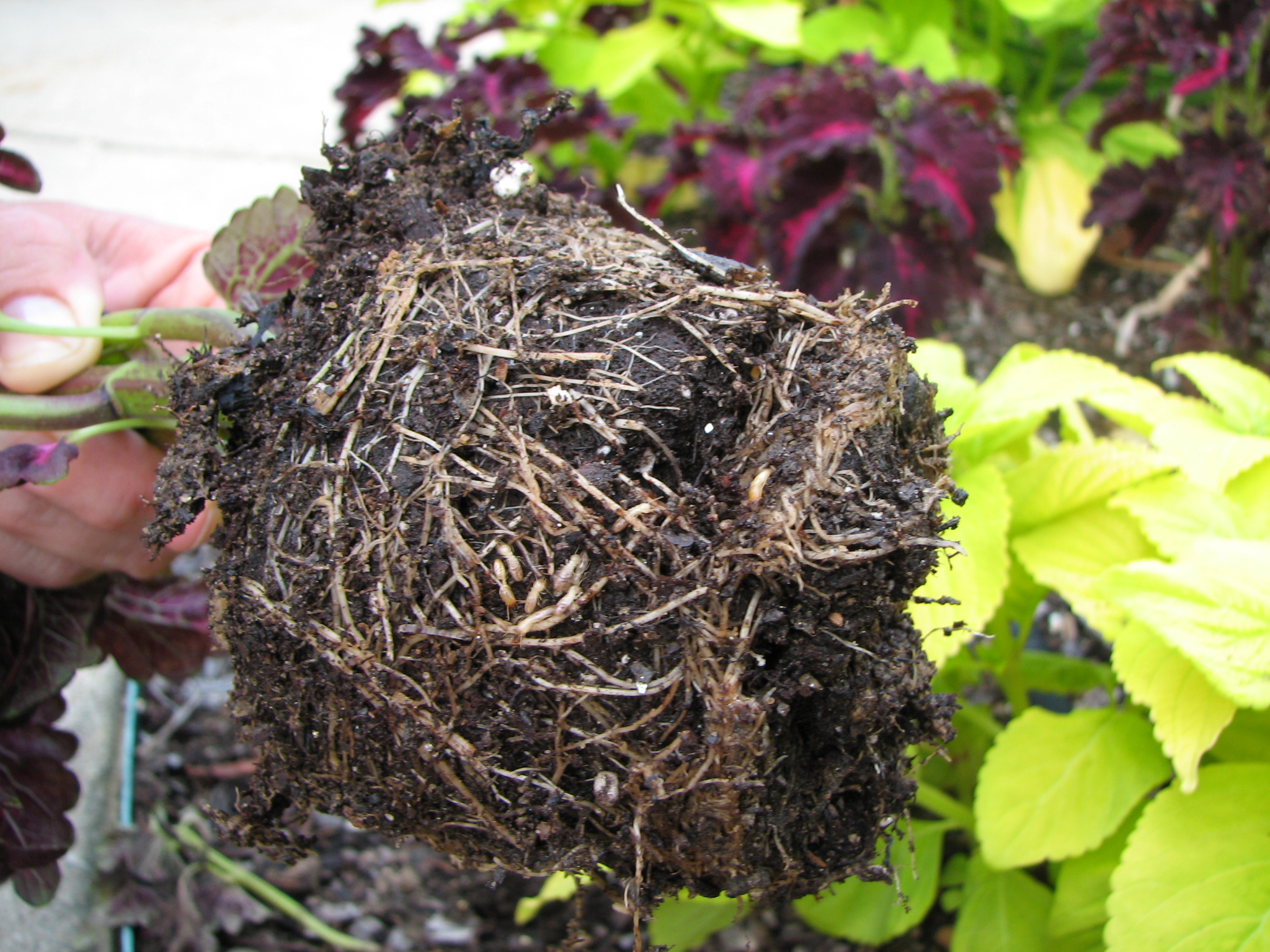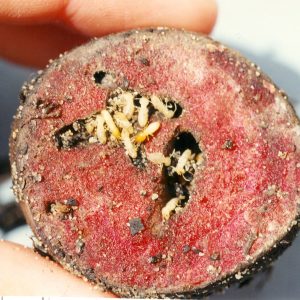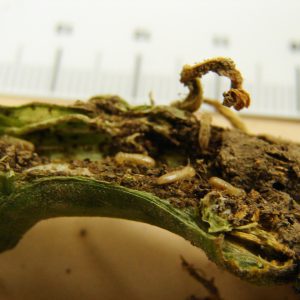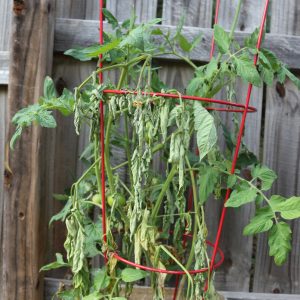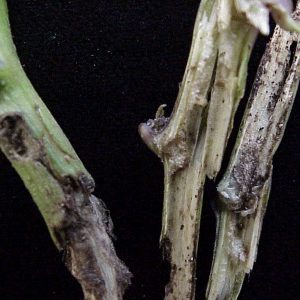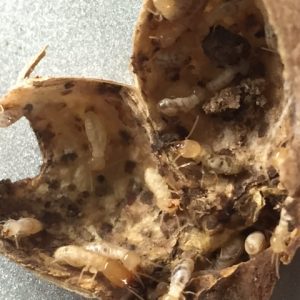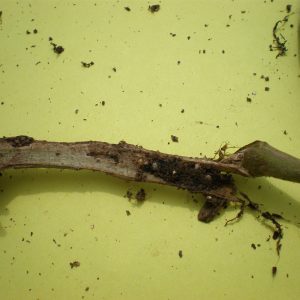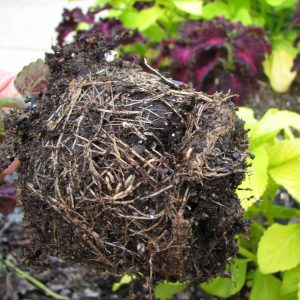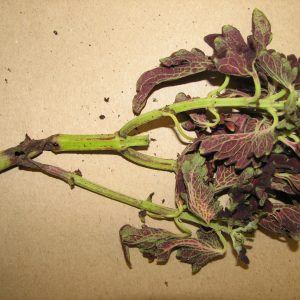Crop Production

Termites invade more than just wood; they also eat plants. Learn sustainable, practical methods to safely and effectively manage termites in your garden.
Termites are known for causing billions of dollars’ worth of damage to homes and other wooden structures. These pests also eat live plants, however, and may be especially problematic if they show up in vegetable gardens, flower beds, and potted fruit trees.
In trying to kill termites, gardeners make some common mistakes, such as using insecticides. Controlling these pests in your garden is a matter of knowing and following the proven do’s and don’ts of termite elimination.
- Figure 1. Formosan subterranean termites eating a beet.
- Figure 2. Squash stem damage from eastern subterranean termite.
- Figure 3. Potted tomato plant infested by eastern subterranean termite (Photo credit: Danna Bradford).
Termite Species and Their Habitat
The two most common termite species in Alabama are the eastern subterranean termite (Reticulitermes flavipes) and the Formosan subterranean termite (Coptotermes formosanus). The eastern subterranean species is widely distributed throughout Alabama, while the Formosan species is established only in the southern and central parts of the state. While both species primarily feed on dead wood, each is capable of attacking live crops and trees, damaging roots, stems, and even fruits.
Termites nest belowground and need two things to survive and develop: moisture and cellulose. Cellulose, or lignocellulose, is the basic component of the cell walls of plants. High moisture levels and available food sources make gardens an ideal place for termites to invade, especially during droughty periods.
Termites tunnel underground in search of moisture and food. Once they find a food source (vegetable), they start eating the bark of the roots or stem immediately below the soil surface (some people refer to the location as the soil/stem interchange point), and then they bore into and feed on the central portions, from inside out, of the root or stem of vegetables, annual flowers, young fruit trees, and potted plants. They don’t eat leaves or flowers, but sometimes they are found invading and eating fruits.
They also attack live trees. The majority of damaging termites nest in the soil around the tree base. They start at the root, munch away the bark below the soil line, and either work their way into the trunk and branches by excavating from inside or they cover the trunk with mud tunnels so they can eat the dead bark.
Plants attacked by termites will wilt and even die, with roots and stems possibly completely hollowed out.
- Figure 4. Bell pepper plant stem hollowed by eastern subterranean termite (Photo credit: Ted Gilbert).
- Figure 5. Peanut damage by eastern subterranean termites (Photo credit: Derek Bryan).
- Figure 6. Tomato stem attacked by eastern subterranean termites
Do’s of Termite Control in Organic Gardens
Eliminate habitats where termites may nest. Remove and clean dead or dying trees, tree stumps, fallen logs, buried wood, landscape lumbers, woody mulch, etc., to create an environment impossible for termites to set up camp. Termites eat all they can, then move to new food sources—quite possibly the plants in your garden or even your house.
Use insect-killing nematodes. Nematodes are used as a natural insecticide for controlling soil-dwelling, soft- bodied insect pests. They are safe to humans, nontarget animals, and plants. Nematode products are relatively easy to use and work fast. Nematodes also are effective in killing many soil-dwelling pests, such as white grubs.
Nematodes actively hunt for termites and other soft- bodied larval pests in the soil; however, they will die after the pests are gone. To use them effectively, follow the instructions on the label and these basic steps:
- Know the soil type of your garden and buy the right nematode product. Different nematodes work best in different soils. For example, Steinernema species work best in cultivated soil, while Heterorhabditis species work best in undisturbed soils. Soil type isn’t crucial for the Heterorhabditis species but is crucial for Steinernema species. For example, S. feltiae works best in clay or silt, while S. carpocapsae works best in sandy soils.
- Water before and after nematode application to keep soil moist, but do not soak the area.
- Apply early in the morning or when the sun is low on the horizon to avoid desiccation and UV radiation.
- Apply when soil temperatures are between 42 and 95 degrees F
- Do not apply fertilizer 2 weeks before or after nematode applications. High levels of nitrogen can reduce nematode efficacy.
- Apply nematode products when you have a termite problem. It is not for preventive control.
- Use nematode products as soon as possible after purchase. They are live organisms and can die if mishandled or not stored properly. If you have to store them, keep them in a refrigerator for no more than 2 weeks.
Use bait to kill termites. Termite baits contain very small amounts of insect growth regulator (IGR) insecticides that work only after termites ingest them. Baits are confined in stations that can be installed in the ground around your home, garden, tree base, or landscape. Foraging termites will locate and eat the bait and be killed.
After the infestation has been eliminated, foraging termites from neighboring colonies may reinvade the area. This necessitates periodic monitoring and maintenance of bait stations. Although some baits can be purchased online, termite baiting is usually a job best suited for professionals.
Remove the soil containing termites and replace it with “clean” soil. This may deter termites temporarily.
-
Figure 7a. Eastern subterranean termites in the roots of Coleus,
entering the stem from the soil/stem interchange point.
-
Figure 7b. Eastern subterranean termites in the roots of Coleus
entering the stem from the soil/stem interchange point.
Don’ts of Termite Control in Organic Gardens
Do not use insecticide sprays. Over-the-counter insecticides won’t kill all the termites and can harm beneficial insects or plants. More than 99 percent of termites live deep underground, traveling from nests to food sources. When you spray, more termites will come to the surface.
Using treated wood for raised gardens won’t help. Although the new pressure-treated woods are considered safe, the chemicals are leachable when wet.
Vegetable plants, including the vegetables themselves, may absorb the chemicals. In addition, timber in direct contact with the ground, combined with high moisture content, can attract termites to nest underneath and feed on the timber.
Removing and replacing topsoil does not solve the problem. Termites seen in topsoil most likely come from colonies that are deep underground, far from your garden; therefore, removing the topsoil from your garden will not help, as more termites will reinvade.
Termites build massive underground networks of concealed tunnels that connect them from their nests to multiple feeding sources. There is a high likelihood that your garden is only one of those sources. As long as there is moisture and cellulose food, termites will reinfest your garden.
Potted plants should not be placed directly on top of ground soil. Termites can easily access the potted plants this way.
 Xing Ping Hu, Extension Specialist, Professor, Entomology and Plant Pathology, Auburn University
Xing Ping Hu, Extension Specialist, Professor, Entomology and Plant Pathology, Auburn University
New July 2021, Management Tactics for Termites Infesting Organic Vegetables, ANR-2804

